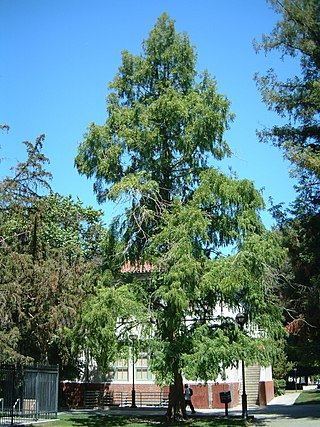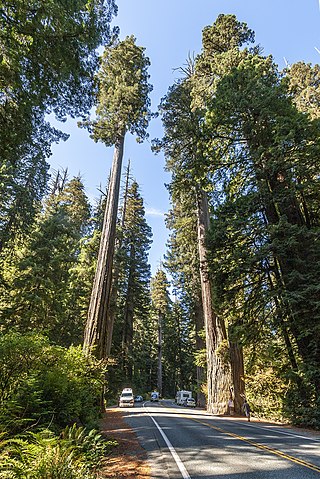Related Research Articles

Metasequoia glyptostroboides, the dawn redwood, is a fast-growing, endangered deciduous conifer. It is the sole living species of the genus Metasequoia, one of three genera in the subfamily Sequoioideae of the family Cupressaceae. It now survives in the wild only in wet lower slopes and montane river and stream valleys in the border region of Hubei and Hunan provinces and Chongqing municipality in south-central China, notably in Lichuan county in Hubei. Although the shortest of the redwoods, it can grow to 167 ft (51 m) in height.

Humboldt Redwoods State Park is a state park of California, United States, containing Rockefeller Forest, the world's largest remaining contiguous old-growth forest of coast redwoods. It is located 30 miles (48 km) south of Eureka, California, near Weott in southern Humboldt County, within Northern California, named after the great German nineteenth-century scientist, Alexander von Humboldt. The park was established by the Save the Redwoods League in 1921 largely from lands purchased from the Pacific Lumber Company. Beginning with the dedication of the Raynal Bolling Memorial Grove, it has grown to become the third-largest park in the California State Park system, now containing 51,651 acres (20,902 ha) through acquisitions and gifts to the state.
Richard Preston is a writer for The New Yorker and bestselling author who has written books about infectious disease, bioterrorism, redwoods and other subjects, as well as fiction.

The Redwood National and State Parks (RNSP) are a complex of one national park and three California state parks located in the United States along the coast of northern California. The combined RNSP contain 139,000 acres (560 km2), and include Redwood National Park, Del Norte Coast Redwoods State Park, Jedediah Smith Redwoods State Park, and Prairie Creek Redwoods State Park. Located within Del Norte and Humboldt counties, the four parks protect 45 percent of all remaining coast redwood old-growth forests. The species is the tallest, among the oldest, and one of the most massive tree species on Earth. The coast redwood was named an endangered species in 2011. The parks preserve other indigenous flora, fauna, grassland prairie, cultural resources, waterways, and 37 miles (60 km) of pristine coastline.
Canopy research is the field of scientific research based upon data collected in the canopy of trees.
The Stratosphere Giant was once considered the tallest tree in the world. It was discovered in July 2000 growing along Bull Creek in Humboldt Redwoods State Park by Chris Atkins, measuring 112.34 meters (368.6 ft) tall. The discovery was confirmed and made public in 2004, displacing the Mendocino Tree, another coast redwood, from the record books. The tree has continued to grow and measured 113.11 m (371.1 ft) in 2010 and 113.61 m (372.7 ft) in 2013. It is a specimen of the species Sequoia sempervirens, the Coast Redwood. The tree features three prominent burls on the southwestern side of its trunk and is surrounded by a large number of trees of almost equal size. In an effort to avoid damage to the tree's shallow roots by tourism, its exact location was never disclosed to the public.
Kenneth Lawrence Fisher is an American billionaire investment analyst, author, and the founder and executive chairman of Fisher Investments, a fee-only financial adviser. Fisher's Forbes "Portfolio Strategy" column ran from 1984 to 2017, making him the longest continuously-running columnist in the magazine's history. Fisher is now known for writing monthly, native language columns in international outlets. Fisher has authored eleven books on investing, and research papers in the field of behavioral finance. As of August 2022, his net worth is estimated at US$5.1 billion. In 2010, he was included in Investment Advisor magazine's "30 for 30" list of the 30 most influential people in the investment advisory business over the last 30 years. As of December 2021, Fisher's firm managed $208 billion.

Save the Redwoods League is a nonprofit organization whose mission is to protect and restore coast redwood and giant sequoia trees through the preemptive purchase of development rights of notable areas with such forests.
Hyperion is a coast redwood in California that is the world's tallest known living tree, measuring 115.92 m (380.3 ft).

Iluvatar is a redwood tree in Prairie Creek Redwoods State Park in Northern California that has been confirmed to be at least 20.5 feet (6.2 m) in diameter at breast height, and 320 feet (98 m) in height. Measured by botanist Stephen C. Sillett, it is the world's third-largest coast redwood, the largest being Lost Monarch.

Del Norte Titan is a coast redwood tree in Del Norte County, Northern California, that was confirmed by measuring to be at least 23.7 feet (7.2 m) in diameter at breast height, and 307 feet (94 m) tall. Measured by botanist Stephen Sillett, it ranks as the world's fifth largest coast redwood. One source recognizes it as the largest based on a single-stem measurement. But the source's recognition pre-dates a 2014 discovery in the redwood parks that is larger. Lost Monarch in the same park, is actually larger with more wood volume than Del Norte Titan, if basal stems are included. The fourth largest coastal redwood is in Prairie Creek Redwoods State Park called Iluvatar.

Atlas Grove is a grove of Coast redwood trees within Prairie Creek Redwoods State Park, in Humboldt County, northern California. It contains the third largest known Coast redwood, Iluvatar.

The Wild Trees: A Story of Passion and Daring is a non-fiction book by Richard Preston about California's coastal redwoods and the recreational climbers who climbed them. It is a narrative-style collection of stories from climbers who pioneered redwood climbing, including botanist Steve Sillett, lichenologist Marie Antoine, and Michael Taylor. They inadvertently discovered a thriving ecosystem hidden among the tree tops, 60–90 meters (200–300 ft) above, of redwood lattices, berry bushes, bonsai trees, epiphytes, lichens, voles, and salamanders.

Michael W. Taylor is a leading discoverer of champion and tallest trees - most notably coast redwoods. In 2006, Taylor co-discovered the tallest known tree in the world, a coast redwood now named "Hyperion". He also discovered "Helios" and "Icarus", the 2nd and 3rd tallest.

Sequoia sempervirens is the sole living species of the genus Sequoia in the cypress family Cupressaceae. Common names include coast redwood, coastal redwood and California redwood. It is an evergreen, long-lived, monoecious tree living 1,200–2,200 years or more. This species includes the tallest living trees on Earth, reaching up to 115.9 m (380.1 ft) in height and up to 8.9 m (29 ft) in diameter at breast height. These trees are also among the longest-living organisms on Earth. Before commercial logging and clearing began by the 1850s, this massive tree occurred naturally in an estimated 810,000 ha along much of coastal California and the southwestern corner of coastal Oregon within the United States.

Pseudotsuga menziesii var. menziesii, commonly known as Coast Douglas-fir, Pacific Douglas-fir, Oregon pine, or Douglas spruce, is an evergreen conifer native to western North America from west-central British Columbia, Canada southward to central California, United States. In Oregon and Washington its range is continuous from the Cascades crest west to the Pacific Coast Ranges and Pacific Ocean. In California, it is found in the Klamath and California Coast Ranges as far south as the Santa Lucia Mountains with a small stand as far south as the Purisima Hills, Santa Barbara County. In the Sierra Nevada it ranges as far south as the Yosemite region. It occurs from near sea level along the coast to 1,800 metres (5,900 ft) in the California Mountains. Further inland, coast Douglas-fir is replaced by Rocky Mountain or interior Douglas-fir. Interior Douglas-fir intergrades with coast Douglas-fir in the Cascades of northern Washington and southern British Columbia.

Bull Creek is the largest Eel River tributary drainage basin preserved within Humboldt Redwoods State Park. The basin contains the world's largest remaining contiguous old-growth forest of coast redwoods. Bull Creek flows in a clockwise semi-circle around 3,373-foot (1,028-meter) Grasshopper Mountain to enter the South Fork Eel River approximately 1.5 miles (2.4 km) upstream of the South Fork confluence with the Eel River.

References
- 1 2 3 Preston, Richard (2005-02-15). "Climbing the Redwoods". The New Yorker . Retrieved 2007-07-31.
- ↑ "Ken Fisher Chair to Take Redwood Ecology to New Heights". Newswise Science News. 2006-02-03. Retrieved 2007-07-31.
- 1 2 3 "About Professor Stephen Sillett". Archived from the original on 2007-09-29. Retrieved 2007-07-31.
- 1 2 3 4 5 6 Preston, Richard (2007). The Wild Trees: A Story of Passion and Daring . Random House. ISBN 978-1-4000-6489-2.
- ↑ "Doing Canopy Science". Archived from the original on 2007-07-14. Retrieved 2007-07-31.
- 1 2 Glen, Martin (2006-08-07). "Eureka: New tallest living thing discovered". San Francisco Chronicle . Retrieved 2007-07-31.
- 1 2 "Kenneth L. Fisher Chair in Redwood Forest Ecology". Archived from the original on 2007-07-09. Retrieved 2007-07-31.
- ↑ "About the Chair Founder, Kenneth L. Fisher". Archived from the original on 2007-09-29. Retrieved 2007-07-31.
- 1 2 Preston, Richard (2006-10-09). "Tall for its age". The New Yorker . Retrieved 2007-07-31.
- ↑ McClintock, Jack (2002-01-05). "The Life, Death, and Life of a Tree". Discover . Retrieved 2007-07-31.
- ↑ Ananthaswamy, Anil (2002-11-09). "Inside the hanging gardens of Arcata". New Scientist . Retrieved 2007-07-31.
- ↑ "Treetop Scholars". National Geographic . Archived from the original on February 3, 2006. Retrieved 2007-07-31.
- ↑ "Humboldt State University - Academic Affairs". Humboldt State University. Retrieved 2007-07-31.
- 1 2 "Stephen C. Sillett's CV". Archived from the original on 2007-09-27. Retrieved 2007-07-31.